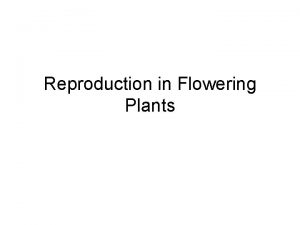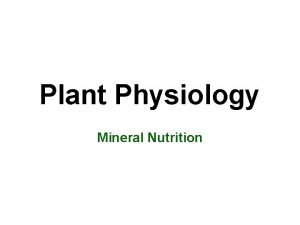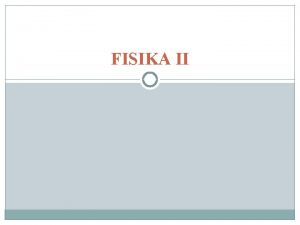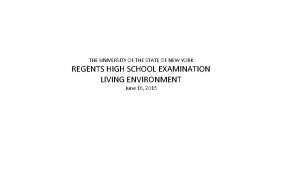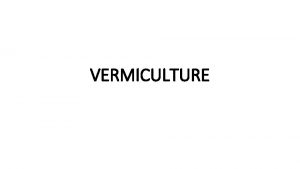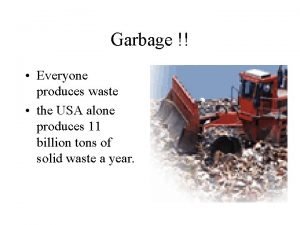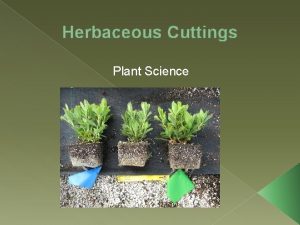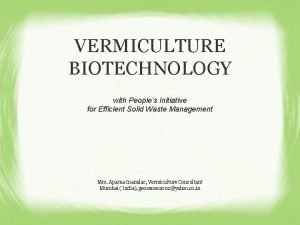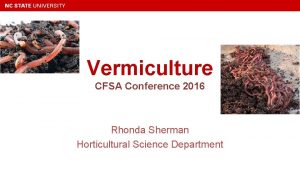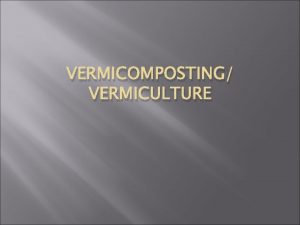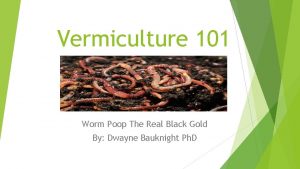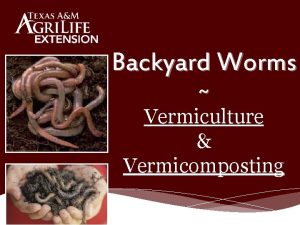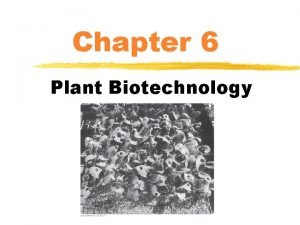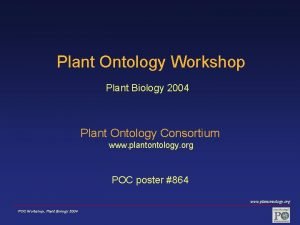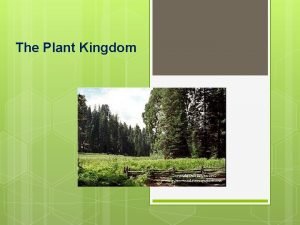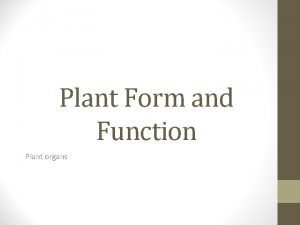VERMICULTURE Why essential All the plant produces which















- Slides: 15

VERMICULTURE

Why essential: • All the plant produces which fall down naturally or obtained as a result of garden maintenance need to be recycled in an environment friendly manner. • As per the rules of the civic bodies, all organizations have to find a way to dispose of such produces preferably within their premises. • Piling of waste in a haphazard manner will emanate the landfill gas which is mixture of gases. In landfill gas 40 -60% is methane (CH 4)and the remaining is mainly carbon dioxide (CO 2).

Principle: • Garden waste is subjected to get through some special species of worms under controlled conditions of moisture and temperature to get worm’s excreta as vermicast or vermicompost.

Design: • A thatched roof shed preferably open from all sides on unpaved (kachcha) floor is erected in east-west direction to protect from direct sunlight. • Pits of suitable sizes matching the garden waste yield be made. • Pits may be of pucca / kachcha base. • One kg worms process half kg shredded waste per day. • The bottom of the pit should have a 20 cm thick bedding as home to worms.

PITS HAVING THATCHED ROOF

Continued: • The bedding may be of shredded corrugated cardboard, shredded paper or peat moss etc. • The temperature of the bed should be in the range of 20 -30°C. • The moisture content in the bedding should be in the range of 4050%. • Normally 5 Cm thick layer should be laid each day.

SHREDDED CARD BOARD AND NEWSPAPER LAYER TO MAKE WORM BEDDING

Type of Worms to be used: • Red worms (Eisenia fetida), red wiggler, manure worm, red hybrid and tiger worms are the species which survive the conditions of the process. • Earth worms are hermaphrodite and they grow easily. • Since they are the cutaneous creature, suitable moisture level is necessary for their survival. • They should be protected from creatures like centipedes, predatory mites, fruit flies, rove beetles and ants. • Earth worms should be introduced in the pits after preparing the bed.

WORMS

Procedure: • All the plant produces should be brought to vericulture plant and stacked to dry. • The dried produces should be segregated thoroughly for plastics, metals, stones and un-shreddable items. • The segregated material is shredded in a shredding machine. • The obtained shredded material is spread evenly in the pits in layers. • On loading to full the pit should be covered with hay / straw etc. for a thickness of 5 cm and left for next 30 days. • Watering should be done during the period of stacking in layers and afterwards also to keep the moisture level maintained.

SHREDDING MACHINE

Continued: • Bed should neither be dry nor soggy. • All the organic waste should be turned over or mixed periodically leaving the bedding. • In 60 -90 days depending on the size of the pit compost will be ready. • Compost is ready when the material is moderately loose or crumbly and the colour of the compost is dark brown. • It will be light weight, black, granular and humus rich.

VERMICOMPOST

Continued: • To facilitate separating the worms from compost, stop watering for two to three days before emptying as this will force 80% worms to go down the bed. • The remaining worms can be removed from hand.

Properties: • Vermicompost is richer in nutrients than compost prepared by other composting methods. • Improves soil aeration. • Enriches soil with micro-organisms. • Attracts deep burrowing earthworms which remain already present in the soil. • Improves water holding capacity. • Enhances germination, plant growth and crop yield. • Helps to close the metabolic gap through recycling waste on site. • Production reduces greenhouse gas emission.
 Why why why why
Why why why why Part of flower that produces pollen
Part of flower that produces pollen Female parts of flowers
Female parts of flowers Plamatic acid
Plamatic acid Name all the lines name all the segments name all the rays
Name all the lines name all the segments name all the rays Sunflower root
Sunflower root Dont ask why why why
Dont ask why why why Which type of diesel injection produces less noise
Which type of diesel injection produces less noise Gaya gerak listrik adalah
Gaya gerak listrik adalah Identify the structure
Identify the structure Which process produces only identical offspring
Which process produces only identical offspring Plant introduction in plant breeding
Plant introduction in plant breeding Taichum
Taichum Plant introduction in plant breeding
Plant introduction in plant breeding Tronsmo plant pathology and plant diseases download
Tronsmo plant pathology and plant diseases download Tronsmo plant pathology and plant diseases download
Tronsmo plant pathology and plant diseases download

